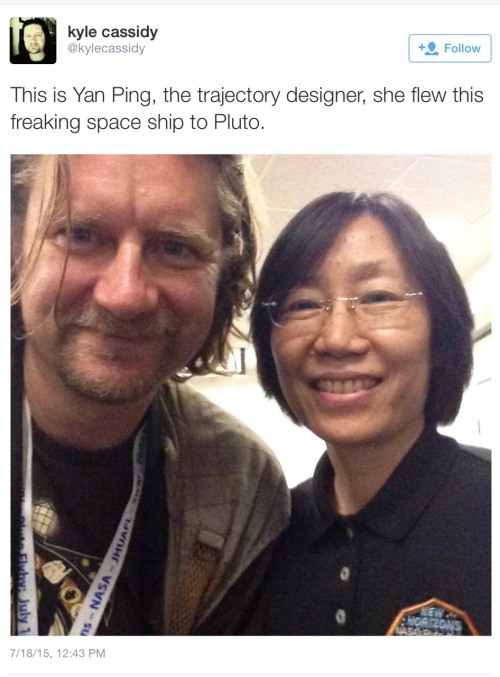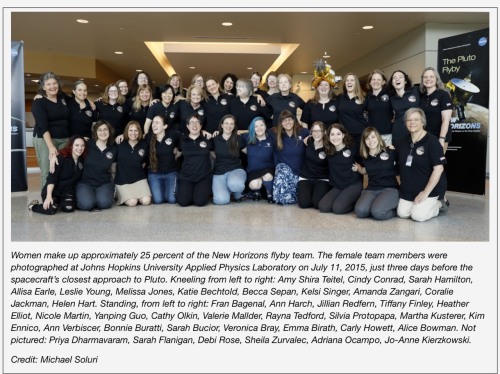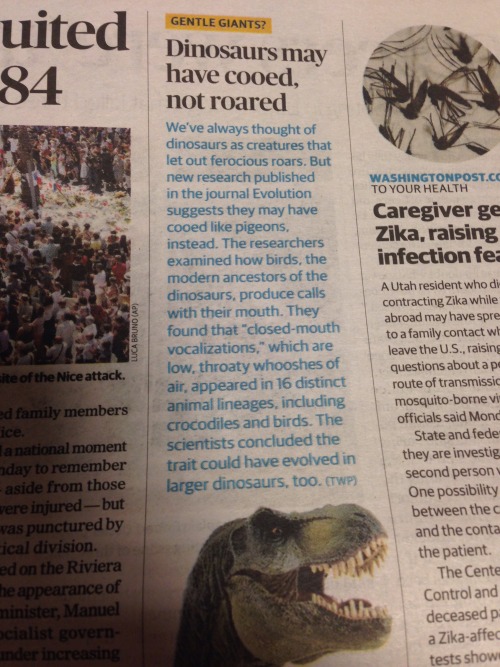Class In Session As Planet X Starts It Off With Our Favorite Dense Objects:






Class in session as Planet X starts it off with our favorite dense objects:
Neutron Stars!
http://www.space.com/22180-neutron-stars.html
More Posts from Science-is-magical and Others



Women scientists made up 25% of the Pluto fly-by New Horizon team. Make sure you share this, because erasing women’s achievements in science and history is a tradition. Happens every day.
.
http://pluto.jhuapl.edu/News-Center/News-Article.php?page=20150712

We don’t have any real pictures of the Milky Way galaxy. Most non-illustrated images of the entire Milky Way spiral are actually of another spiral galaxy called Messier 74. It’s impossible to take a full photo of the Milky Way’s spiral structure because it’s about 100,000 light-years across, and we’re stuck on the inside. Source Source 2 Source 3

It’s #InternationalKissingDay! Here’s some topical lipstick chemistry. More info/high-res image: http://wp.me/s4aPLT-lipstick

Babies don’t just look cute, scientists find
What is it about the sight of an infant that makes almost everyone crack a smile? Big eyes, chubby cheeks, and a button nose? An infectious laugh, soft skin, and a captivating smell? While we have long known that babies look cute, Oxford University researchers have found that cuteness is designed to appeal to all our senses.
They explain that all these characteristics contribute to ‘cuteness’ and trigger our caregiving behaviours, which is vital because infants need our constant attention to survive and thrive. The study is published in the journal Trends in Cognitive Sciences.
Morten Kringelbach, who together with Eloise Stark, Catherine Alexander, Professor Marc Bornstein and Professor Alan Stein, led the work in the Department of Psychiatry at the University of Oxford, said: ‘Infants attract us through all our senses, which helps make cuteness one of the most basic and powerful forces shaping our behaviour.’
Reviewing the emerging literature on how cute infants and animals affect the brain, the Oxford University team found that cuteness supports key parental capacities by igniting fast privileged neural activity followed by slower processing in large brain networks also involved in play, empathy, and perhaps even higher-order moral emotions.
The data shows that definitions of cuteness should not be limited just to visual features but include positive infant sounds and smells. From an evolutionary standpoint, cuteness is a very potent protective mechanism that ensures survival for otherwise completely dependent infants.
Professor Kringelbach said: ‘This is the first evidence of its kind to show that cuteness helps infants to survive by eliciting caregiving, which cannot be reduced to simple, instinctual behaviours. Instead, caregiving involves a complex choreography of slow, careful, deliberate, and long-lasting prosocial behaviours, which ignite fundamental brain pleasure systems that are also engaged when eating food or listening to music, and always involve pleasant experiences.’
The study shows that cuteness affects both men and women, even those without children.
‘This might be a fundamental response present in everyone, regardless of parental status or gender, and we are currently conducting the first long-term study of what happens to brain responses when we become parents.’ said Kringelbach.
23 science facts we didn't know at the start of 2016
1. Gravitational waves are real. More than 100 years after Einstein first predicted them, researchers finally detected the elusive ripples in space time this year. We’ve now seen three gravitational wave events in total.
2. Sloths almost die every time they poop, and it looks agonising.
3. It’s possible to live for more than a year without a heart in your body.
4. It’s also possible to live a normal life without 90 percent of your brain.
5. There are strange, metallic sounds coming from the Mariana trench, the deepest point on Earth’s surface. Scientists currently think the noise is a new kind of baleen whale call.
6. A revolutionary new type of nuclear fusion machine being trialled in Germany really works, and could be the key to clean, unlimited energy.
7. There’s an Earth-like planet just 4.2 light-years away in the Alpha Centauri star system - and scientists are already planning a mission to visit it.
8. Earth has a second mini-moon orbiting it, known as a ‘quasi-satellite’. It’s called 2016 HO3.
9. There might be a ninth planet in our Solar System (no, Pluto doesn’t count).
10. The first written record demonstrating the laws of friction has been hiding inside Leonardo da Vinci’s “irrelevant scribbles” for the past 500 years.
11. Zika virus can be spread sexually, and it really does cause microcephaly in babies.
12. Crows have big ears, and they’re kinda terrifying.
13. The largest known prime number is 274,207,281– 1, which is a ridiculous 22 million digits in length. It’s 5 million digits longer than the second largest prime.
14. The North Pole is slowly moving towards London, due to the planet’s shifting water content.
15. Earth lost enough sea ice this year to cover the entire land mass of India.
16. Artificial intelligence can beat humans at Go.
17. Tardigrades are so indestructible because they have an in-built toolkit to protect their DNA from damage. These tiny creatures can survive being frozen for decades, can bounce back from total desiccation, and can even handle the harsh radiation of space.
18. There are two liquid states of water.
19. Pear-shaped atomic nuclei exist, and they make time travel seem pretty damn impossible.
20. Dinosaurs had glorious tail feathers, and they were floppy.
21. One third of the planet can no longer see the Milky Way from where they live.
22. There’s a giant, 1.5-billion-cubic-metre (54-billion-cubic-foot) field of precious helium gas in Tanzania.
23. The ‘impossible’ EM Drive is the propulsion system that just won’t quit. NASA says it really does seem to produce thrust - but they still have no idea how. We’ll save that mystery for 2017.
-
 myfaceisapotato liked this · 2 years ago
myfaceisapotato liked this · 2 years ago -
 ncdoppalapudi liked this · 3 years ago
ncdoppalapudi liked this · 3 years ago -
 mariganath reblogged this · 3 years ago
mariganath reblogged this · 3 years ago -
 potato-admires-art reblogged this · 3 years ago
potato-admires-art reblogged this · 3 years ago -
 belladonna4u liked this · 3 years ago
belladonna4u liked this · 3 years ago -
 mildred-meadowlark reblogged this · 3 years ago
mildred-meadowlark reblogged this · 3 years ago -
 itslunasapprentice liked this · 3 years ago
itslunasapprentice liked this · 3 years ago -
 artinwood54 liked this · 3 years ago
artinwood54 liked this · 3 years ago -
 raythen-nightsong reblogged this · 3 years ago
raythen-nightsong reblogged this · 3 years ago -
 blynn-safespace reblogged this · 3 years ago
blynn-safespace reblogged this · 3 years ago -
 steelshard liked this · 3 years ago
steelshard liked this · 3 years ago -
 antipelargy reblogged this · 3 years ago
antipelargy reblogged this · 3 years ago -
 itsapunnyday reblogged this · 3 years ago
itsapunnyday reblogged this · 3 years ago -
 supercomputer276 reblogged this · 3 years ago
supercomputer276 reblogged this · 3 years ago -
 fu3g0n3gr0 reblogged this · 3 years ago
fu3g0n3gr0 reblogged this · 3 years ago -
 cirrus-tempestas reblogged this · 3 years ago
cirrus-tempestas reblogged this · 3 years ago -
 skcirthinq liked this · 3 years ago
skcirthinq liked this · 3 years ago -
 yueci reblogged this · 3 years ago
yueci reblogged this · 3 years ago -
 yueci liked this · 3 years ago
yueci liked this · 3 years ago -
 mariganath liked this · 3 years ago
mariganath liked this · 3 years ago -
 ciudadanodin reblogged this · 3 years ago
ciudadanodin reblogged this · 3 years ago -
 ciudadanodin liked this · 3 years ago
ciudadanodin liked this · 3 years ago -
 hypergnome liked this · 3 years ago
hypergnome liked this · 3 years ago -
 yellowfoot-06 reblogged this · 3 years ago
yellowfoot-06 reblogged this · 3 years ago -
 yellowfoot-06 liked this · 3 years ago
yellowfoot-06 liked this · 3 years ago -
 zerosocialskillz reblogged this · 3 years ago
zerosocialskillz reblogged this · 3 years ago -
 zerosocialskillz liked this · 3 years ago
zerosocialskillz liked this · 3 years ago -
 fun-with-colors reblogged this · 3 years ago
fun-with-colors reblogged this · 3 years ago -
 smalllonelyegg reblogged this · 3 years ago
smalllonelyegg reblogged this · 3 years ago -
 insomniacoon liked this · 3 years ago
insomniacoon liked this · 3 years ago -
 smalllonelyegg liked this · 3 years ago
smalllonelyegg liked this · 3 years ago -
 valigarmander liked this · 3 years ago
valigarmander liked this · 3 years ago -
 justanothervirus reblogged this · 3 years ago
justanothervirus reblogged this · 3 years ago -
 unearthly-but-still-thinking reblogged this · 3 years ago
unearthly-but-still-thinking reblogged this · 3 years ago -
 wonderbon reblogged this · 3 years ago
wonderbon reblogged this · 3 years ago -
 wonderbon liked this · 3 years ago
wonderbon liked this · 3 years ago -
 bongus777 liked this · 3 years ago
bongus777 liked this · 3 years ago -
 ethylsilver reblogged this · 3 years ago
ethylsilver reblogged this · 3 years ago -
 ethylsilver liked this · 3 years ago
ethylsilver liked this · 3 years ago -
 slightlyemoelephant liked this · 3 years ago
slightlyemoelephant liked this · 3 years ago -
 argonraptor liked this · 3 years ago
argonraptor liked this · 3 years ago -
 donutveins liked this · 3 years ago
donutveins liked this · 3 years ago -
 shinyyellowsunshines reblogged this · 3 years ago
shinyyellowsunshines reblogged this · 3 years ago -
 drearydaffodil liked this · 3 years ago
drearydaffodil liked this · 3 years ago -
 monterrang-parkin reblogged this · 3 years ago
monterrang-parkin reblogged this · 3 years ago -
 thomastanker02 reblogged this · 3 years ago
thomastanker02 reblogged this · 3 years ago




